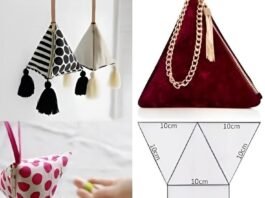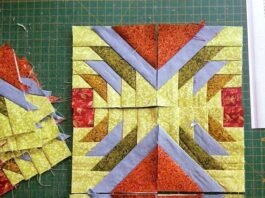Looking to add a touch of handmade charm to your morning coffee or afternoon tea? This Mug or Cup Holder – Tutorial is just the project you need. Easy to sew, practical to use, and customizable to your taste, this quilted accessory protects your surfaces while showing off your creativity. Whether you’re a beginner or seasoned quilter, this project is a fun and rewarding way to use your favorite fabric scraps.
The mug or cup holder is more than just functional—it’s an opportunity to express your style and care for the little details that make home life cozy. You can make one for yourself, gift them to friends and coworkers, or even sell them at craft fairs. With endless possibilities for design, you’ll never run out of ways to enjoy this small but mighty project.
In this tutorial, you’ll learn how to create a quilted mug or cup holder step by step, including tips on fabric choices, assembly, and decorative ideas to make your piece truly one of a kind.

1. Why Make a Mug or Cup Holder
Creating a mug or cup holder offers several benefits beyond just having a spot for your drink. It’s a project that brings usefulness, beauty, and warmth into one compact piece.
SEE OTHER FACE PATTERNS HERE!
First, it’s fast and beginner-friendly. You can complete a holder in under an hour, making it an excellent option for spontaneous sewing sessions or last-minute gifts.
Second, it uses up scraps. Small fabric pieces that might otherwise go to waste can find new life in these mini quilted projects.
Third, it’s practical. Quilted mug holders protect your furniture from heat and moisture, especially when made with insulating materials.
Fourth, it adds a personal touch. Instead of store-bought coasters, you can make holders in fabrics that reflect your style, season, or mood.
Fifth, it’s an ideal gift. Everyone uses mugs, and a handmade cup holder makes for a thoughtful and unique present.
Sixth, it builds your quilting skills. You’ll practice piecing, quilting, binding, and sometimes even appliqué in a small-scale format, which is perfect for learning and experimenting.
2. Materials and Tools You’ll Need
Gathering your supplies is simple and fun, especially if you’re using materials already in your stash. Here’s what you’ll need for your quilted mug or cup holder.
Fabric:
-
One piece of cotton fabric for the front (6” x 6” or desired size)
-
One piece of cotton backing fabric
-
Optional: fabric scraps for patchwork or appliqué designs
Batting:
-
Cotton or polyester batting (same size as the fabric)
-
Or insulating material like Insul-Bright for added heat protection
Binding (optional):
-
Bias binding or homemade binding strips (approx. ½” wide finished)
Notions & Tools:
-
Sewing machine
-
Thread in matching or contrasting color
-
Rotary cutter or scissors
-
Quilting ruler
-
Pins or clips
-
Iron and ironing board
These materials are flexible—feel free to change the size, colors, or batting thickness depending on how you plan to use the holder.
3. Step-by-Step Mug or Cup Holder Tutorial
Follow these simple steps to make your very own quilted mug or cup holder. This version uses a basic quilt sandwich with optional binding for a clean, professional finish.
Step 1: Cut your materials
Cut one piece of top fabric, one backing fabric, and one piece of batting all to the same size—commonly 6″ x 6″ or 5″ x 7″. You can also sew scraps together to create a patchwork top layer.
Step 2: Create your quilt sandwich
Layer your materials in this order:
-
Backing fabric (right side down)
-
Batting
-
Top fabric (right side up)
Smooth all layers and pin or clip in place.
Step 3: Quilt the layers
Using a straight stitch, quilt through all three layers. You can go with simple lines, a criss-cross grid, or free-motion quilting if you’re experienced. Quilting helps keep the layers together and adds visual interest.
Step 4: Trim and square
After quilting, trim the edges so all sides are even and clean. This step ensures your binding (if used) will go on smoothly.
Step 5: Add the binding (optional)
If you want a bound edge, use double-fold bias tape or make your own binding strips. Attach using your sewing machine—first sew the binding to the front, fold it over the edge, and stitch it down on the back.
Step 6: Finish the edges (alternative to binding)
If you’re skipping binding, you can simply sew the quilted square right sides together with another piece of backing fabric, leaving a small gap. Turn it right-side-out, press, and topstitch around the edge to close the gap and finish.
Step 7: Add personal touches
Add appliqué, embroidery, or a small fabric tag with your name or initials. Little details go a long way in making your mug holder unique.
Your handmade mug or cup holder is now ready to use or give!
4. Creative Variations and Seasonal Ideas
Once you’ve mastered the basic mug or cup holder, it’s time to explore fun variations and themes. These small projects are a great canvas for your creativity.
Holiday-themed holders
Use festive fabrics to make cup holders for Christmas, Halloween, Easter, or Valentine’s Day. Add themed appliqué like hearts, pumpkins, or snowflakes.
Patchwork style
Sew fabric scraps into squares, strips, or triangles for a mini patchwork quilt look. Great for using leftover charm squares or jelly roll ends.
Personalized gifts
Embroider names, initials, or a short phrase like “coffee time” or “you’re brew-tiful.” These make thoughtful gifts for teachers, coworkers, or friends.
Mug rugs
Make the holder slightly larger (e.g., 6” x 10”) to hold both a mug and a snack. Mug rugs are very popular and useful!
Add a pocket
Sew on a small pocket to one side for a tea bag or spoon. This adds functionality and a little flair.
Shape experimentation
Try round, hexagon, or heart shapes instead of the usual square or rectangle. Use a template and adjust your binding accordingly.
These projects are small, so don’t be afraid to try something new!
FAQ – Mug or Cup Holder Tutorial
Can I make a mug holder without a sewing machine?
Yes, you can hand sew it using running stitch or backstitch, though it may take longer. A machine speeds up the process, especially for quilting and binding.
What type of batting is best?
Cotton batting is common, but Insul-Bright is ideal if you want heat resistance. Avoid very thick batting that might cause cups to wobble.
Is this project good for beginners?
Absolutely! It’s one of the best beginner sewing or quilting projects because it’s small, simple, and forgiving of small mistakes.
Can I wash the mug holder?
Yes, just be sure to use washable fabrics and cotton or polyester batting. Machine wash on gentle and air dry or press with a warm iron.
How big should a cup holder be?
Sizes vary, but common dimensions are 5″x5″, 6″x6″, or 5″x7″. Mug rugs are usually larger—about 6″x10″—to accommodate a mug and snack.
Can I sell mug holders at craft fairs?
Definitely! They’re popular and quick to make. Just be sure to use quality materials and finish edges neatly for best results.
Conclusion
The Mug or Cup Holder – Tutorial is a perfect blend of form and function, giving you a chance to make something useful, beautiful, and totally customizable. Whether you’re crafting for yourself, making handmade gifts, or just want a quick sewing project, these mini quilts are a joy to create.
From choosing your favorite fabrics to experimenting with quilting techniques, each piece is an opportunity to practice and play. And best of all, they’re a great way to show someone you care—one stitch at a time.
PATTERN VIDEO:
Have you tried making a mug or cup holder? ☕🧵 We’d love to hear about your experience! Share your creations, tips, and suggestions in the comments. Let’s inspire each other with the magic of handmade quilting!




